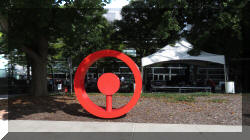
Corning Museum of Glass - Corning, NY - 2018
Updated: 05/07/19
Note: If the panel posted next to a
photograph of a glass item appears
as a framed panel, it will expand for easier reading if you 'right click' on it.
On our first visit, the name was the Corning Glass Works. Mary Lou remembers seeing beautiful glass art pieces and watching glass blowers at work, while sitting on bleachers in a special observation area. When we heard the area had been flooded during Hurricane Agnes, we was interested in returning to see how it had changed. Took lots of years, but we did finally arrange a trip to visit the facility now known as, The Corning Museum of Glass.
We planned to visit two days, it was a good decision. On our first day we missed the Welcome Center and main parking lot. We entered from the rear parking lot. Unknown to us, the Museum was hosting a company's large, multi-day workshop. Fortunately, the participants were in a different part of the building that we wanted to explore.
We passed these beautiful glass pumpkins and the old truck as we entered and tried to decide where we needed to go to purchase tickets.
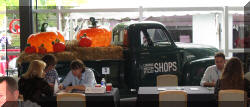
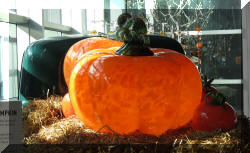
Old truck with glass pumpkins.
Because we were acting 'lost', a women stopped and talked to us. She told us that the demonstrations were about to start and lead us to the "official" entrance where we purchased our two day ticket (using a coupon from the campground). Tickets in hand we headed up the stairs to the demonstration area. (It turned out, she was the person doing the demonstrations.)
Our timing was perfect to go from one demonstration to another. We spent our first day learning about glass blowing, optical fiber, flame working and glass breaking. Except for the glass blowing, the same women did all of the demonstrations, she was an excellent presenter.
Our first stop was up the stairs to the Glass Blowing Demonstration . . .
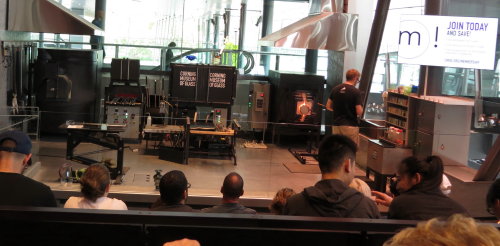 Because of the workshop, the glass blowing was not held in the Innovation Hot
Shop.
Because of the workshop, the glass blowing was not held in the Innovation Hot
Shop.
The area used was set up with the necessary equipment and overhead mirrors and camera's to facility everyone having a good view. There was a delightful translator giving the description of the various processes in English and Japanese.
The demonstrator showed the steps of creating a glass object, gathering melted glass, blowing it, shaping it using various tools and techniques.
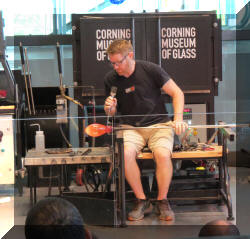
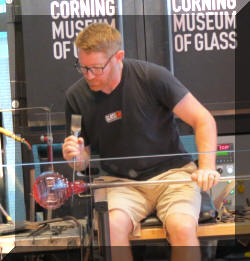
Photo of glass by camera in furnace.
We not expecting the finished bowl. It was fascinating how the talent of the glass blower transformed, what we thought was going to be a vase, into the beautiful, fluted bowl. One was given away as a door prize and there were lots available for purchase in the gift store.
Next demonstration was optical fiber. We were told that currently Corning Incorporated is primarily manufacturing optical fiber.
The demonstration explained how thin threads of glass can carry enormous amount of digital information and power our high-speed information demands. She explained the basic principle, total internal reflection, behind optical fiber. The demonstration showed us how light follows the path of a stream of falling water. Total internal reflection traps the light in the stream of water and traps it the same way in a glass fiber.
The different kinds of material used in making glass was presented. Displays showed more information and uses of optical fiber. The presenter was available for questions following the presentation.
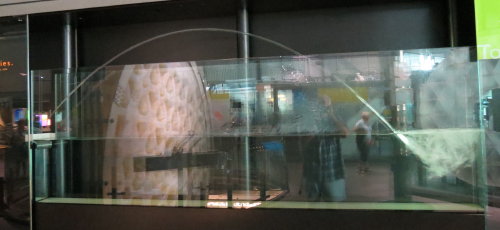
Walking from one demonstration, you see glass blowing art pieces and look down on the gift shop.
Next up on our schedule was the flame working demonstration. We watched a pressed glass penguin being made, it took no specialized skill and very little time. We then watched our presenter create her favorite breed of dog. It was obvious more skill, time and creativity went into making the dog. She gave a running dialogue explaining the process of the work she was doing.
Finished products:
Pressed or molded (inexpensive) Handmade (expensive)
On to Mary Lou's favorite demonstration, the glass breaking demonstration. It details how glass breaks and why.
More beautifully made art pieces . . .
We had taken in a lot of information from the demonstrations and the displays
on the walls. It was time for a break and lunch.
We drove into town, both days, to McDonalds for lunch. This tower is visible from all around the city. We passed it several time during our visit.
After lunch we explored some of the glass exhibits. We were particularly interested in the display of paper weights. When asked for directions, the docent sent us to the second floor directing us to "go to the white dress, turn right".
This beautiful cast glass evening gown became our point of reference.
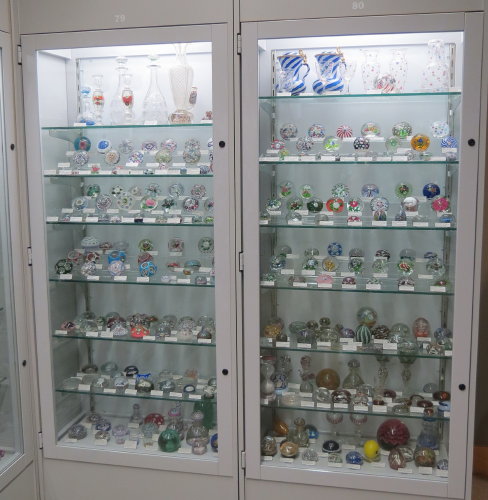 After several twists and turns, we found the paper weights.
One of Fred's grandfathers worked at Corning Glass. Fred
has a paperweight made by him and we wanted see if one like his was in the
display.
After several twists and turns, we found the paper weights.
One of Fred's grandfathers worked at Corning Glass. Fred
has a paperweight made by him and we wanted see if one like his was in the
display.
The following photographs are a representation of the larger glass pieces we enjoyed seeing . . .
Mary Lou spotted this vase on the display cabinet pictured above. She fell in love with it.
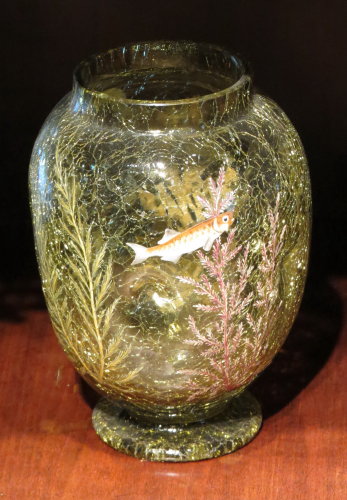
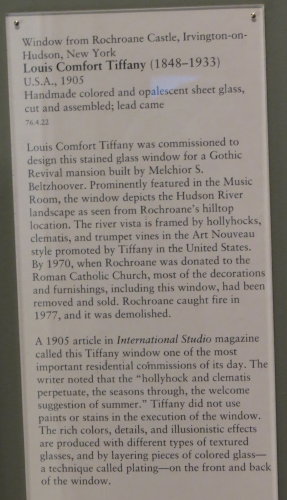
The museum was closing for the day, we left with a plan to take the guided tour, view the Contemporary Art & Design Gallery and the 35 Centuries of Glass Gallery the next day.
The next morning, we were first in line when the doors opened, the front door! This glass sculpture by David Chiculy dominates the space.
Fern Green Tower . . .
While we waited for our guided tour, we walked through the Contemporary Art and Design Galleries.
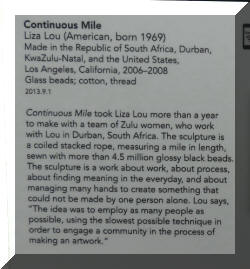
Continuous Mile . . . . is a coiled stacked rope, measuring a mile in length,
sewn with more than 4.5 million glassy black beads. A team of Zulu women worked
for more than one year in Durban, South Africa under the guidance of Liza Lou.
It was very tempting to touch the rope. We were happy to have this sample to touch instead.
Time for our guided Glass Through the Ages Tour. The tour is packed with historical information about the relationship between glass and people. You should plan on an hour for the tour, maybe a little longer, depending on the docent conducting the tour and how busy the museum is the day you visit.
The photographs that follow are a "flavor" of what we saw.
This glass cityscape of Corning, New York is a gift to the museum by a
retiree of the museum. The detail is incredible but did not photograph well. It
is much prettier in person.
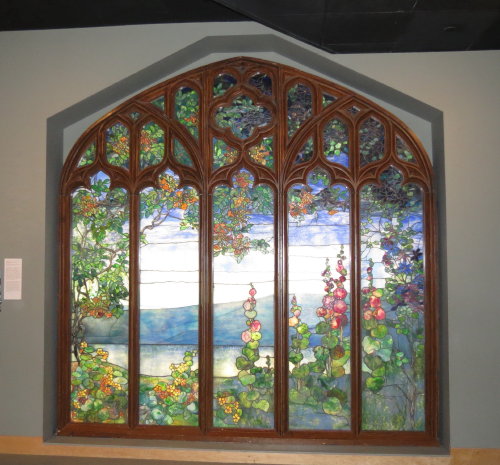 After the tour, we explored on our own. This stained glass window from
Rochroane Castle, Irvington-on-Hudson, New York is just one of several stained
glass windows on display. Titled Window with Hudson River Landscape, created in
1905.
After the tour, we explored on our own. This stained glass window from
Rochroane Castle, Irvington-on-Hudson, New York is just one of several stained
glass windows on display. Titled Window with Hudson River Landscape, created in
1905.
We moved on to cut and engraved glass.
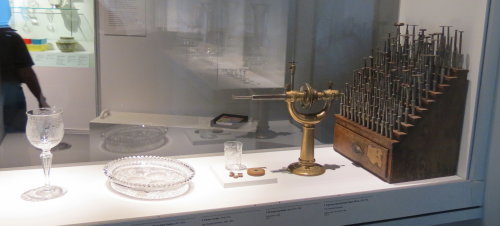
We do not have the video for you to watch.
This is a display of cut glass work. The dish and glasses show the different patters that can be cut into the glass.
In 1998, Corning divested its consumer products lines (including CorningWare and Vision Pyroceramic based cookware, Corelle tableware and Pyrex glass bakeware) by selling the Corning Consumer Products to Borden.
More from the front entrance . . .
 A week's worth of rain from 1972's Hurricane Agnes caused the Chemung
River to overflow its banks and pour five feet, four inches of floodwater into
the Museum. The sign just inside the main door shows the level the water
reached.
A week's worth of rain from 1972's Hurricane Agnes caused the Chemung
River to overflow its banks and pour five feet, four inches of floodwater into
the Museum. The sign just inside the main door shows the level the water
reached.
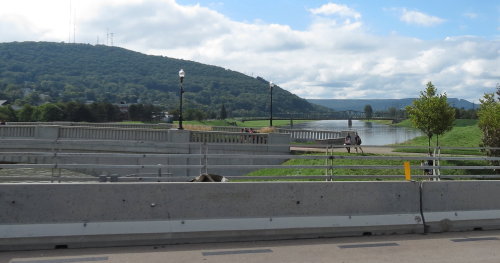
The Chemung River runs through the center of town. Flood prevention changes have been implemented to keep the city and the surrounding area safe from major flooding.
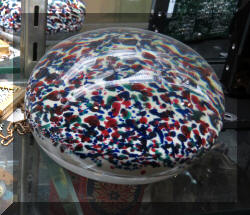 One of many items on display in cases in the front lobby.
One of many items on display in cases in the front lobby.
The photo at the right is of the paperweight Fred was told as a child that his grandfather made. > > > >
We were told at Corning Glass that making paperweights was one of the first projects students were taught.
CORNING MUSEUM OF GLASS, One Museum Way, Corning, New York 14830
All exhibitions and demonstrations are included in the ticket price. Tickets are valid for two consecutive days . . . Adult Tickets $19.50 (55+, AAA, Military and Student Tickets $16.60), Children ages 17 and under are Free, .
For more information go to www.cmogg.org